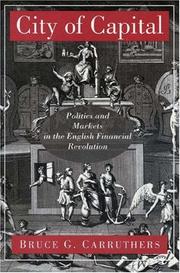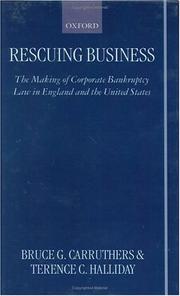| Listing 1 - 10 of 14 | << page >> |
Sort by
|

ISBN: 0691044554 0691049602 1282473220 1400822106 9786612473227 140081118X 9781400822102 9780691049601 Year: 1996 Publisher: Princeton, N.J. Princeton University Press
Abstract | Keywords | Export | Availability | Bookmark
 Loading...
Loading...Choose an application
- Reference Manager
- EndNote
- RefWorks (Direct export to RefWorks)
While many have examined how economic interests motivate political action, Bruce Carruthers explores the reverse relationship by focusing on how political interests shape a market. He sets his inquiry within the context of late Stuart England, when an active stock market emerged and when Whig and Tory parties vied for control of a newly empowered Parliament. Carruthers examines the institutional linkage between politics and the market that consisted of three joint-stock companies--the Bank of England, the East India Company, and the South Sea Company--which all loaned large sums to the government and whose shares dominated trading on the stock market. Through innovative research that connects the voting behavior of individuals in parliamentary elections with their economic behavior in the stock market, Carruthers demonstrates that party conflict figured prominently during the company foundings as Whigs and Tories tried to dominate company directorships. For them, the national debt was as much a political as a fiscal instrument.In 1712, the Bank was largely controlled by the Whigs, and the South Sea Company by the Tories. The two parties competed, however, for control of the East India Company, and so Whigs tended to trade shares only with Whigs, and Tories with Tories. Probing such connections between politics and markets at both institutional and individual levels, Carruthers ultimately argues that competitive markets are not inherently apolitical spheres guided by economic interest but rather ongoing creations of social actors pursuing multiple goals.
History of the United Kingdom and Ireland --- Capital market --- Marché financier --- History --- Histoire --- Bank of England --- East India Company --- South Sea Company --- History. --- Great Britain --- Grande-Bretagne --- Politics and government --- Politique et gouvernement --- Marché financier --- Capital markets --- Market, Capital --- Compagnie du Sud --- Company of Merchants Trading to the South Seas --- Governour and Company of Merchants of Great Britain Trading to the South Seas and Other Parts of America, and for Encouraging the Fishery --- Governor and Company of Merchants of London, Trading into the East Indies --- United Company of Merchants of England, Trading to the East Indies --- English East India Company --- East India Company (English) --- East India Tea Company --- East-India Companie --- United East India Company --- Compagnie des Indes orientales d'Angleterre --- Compagnie unie de marchands d'Angleterre commerçans aux Indes orientales --- Tung Yin-tu kung ssu --- Honourable East-India Company --- Sharikat al-Hind al-Sharqīyah al-Barīṭānīyah --- Engelse Oost-Indische Maatschappy --- Kumpanī-i Hind-i Sharqī --- کمپنى هند شرقى --- Governor and Company of the Bank of England --- Eiran Ginkō --- Old Lady of Threadneedle Street --- Old Lady in Threadneedle Street --- Great Britain. --- Finance --- Financial institutions --- Loans --- Money market --- Securities --- Crowding out (Economics) --- Efficient market theory --- English Company Trading to the East-Indies --- Company of Merchants of Great Britain Trading to the South Seas and Other Parts of America, and for Encouraging the Fishery --- Īsṭa Iṇḍiyā Kampanī
Book
ISBN: 9780691236216 Year: 2022 Publisher: Princeton Princeton University Press
Abstract | Keywords | Export | Availability | Bookmark
 Loading...
Loading...Choose an application
- Reference Manager
- EndNote
- RefWorks (Direct export to RefWorks)
No detailed description available for "The Economy of Promises".
Book
ISBN: 9780691235387 9780691236216 Year: 2022 Publisher: Princeton, N.J. Princeton University Press
Abstract | Keywords | Export | Availability | Bookmark
 Loading...
Loading...Choose an application
- Reference Manager
- EndNote
- RefWorks (Direct export to RefWorks)
"Bruce Carruthers organizes his analysis around different types of credit, offering a roughly chronological discussion of each. The U.S. has always had an economy based on promises, but the manner in which questions about trust and trustworthiness have been posed and answered has evolved in important ways. Their evolution and expansion undergirded the rise of the modern credit economy, but it wasn't a smooth ride forward. Financial crises signalled the widespread collapse of promises, and a collective disbelief in their credibility. Frequently, these collapses motivated public and private attempts to build new institutional scaffolding in support of promises: the 1837 crisis prompted the development of credit ratings; the depression of the 1890s justified passage of a permanent bankruptcy law; the 1907 crisis led to the establishment of the Federal Reserve System; and the Great Depression led to a multitude of public policies in support of financial promises. At various points, political groups perceived the financial system to be deeply unfair, one that privileged some over others. During the 1880s and 1890s, agrarian groups and populists attacked a monetary and banking system that failed to give them adequate credit. During the 1960s and 1970s, women and minorities criticized a discriminatory financial system that denied them full access to consumer and mortgage credit. In The Economy of Promises, Carruthers describes the changes that have occurred, spell out their implications, and explain their significance"--
331.162.4 --- Geschiedenis van het krediet --- History of North America --- anno 1800-1999
Book
ISBN: 0691236216 Year: 2022 Publisher: Princeton, N. J. : Princeton University Press,
Abstract | Keywords | Export | Availability | Bookmark
 Loading...
Loading...Choose an application
- Reference Manager
- EndNote
- RefWorks (Direct export to RefWorks)
"Bruce Carruthers organizes his analysis around different types of credit, offering a roughly chronological discussion of each. The U.S. has always had an economy based on promises, but the manner in which questions about trust and trustworthiness have been posed and answered has evolved in important ways. Their evolution and expansion undergirded the rise of the modern credit economy, but it wasn't a smooth ride forward. Financial crises signalled the widespread collapse of promises, and a collective disbelief in their credibility. Frequently, these collapses motivated public and private attempts to build new institutional scaffolding in support of promises: the 1837 crisis prompted the development of credit ratings; the depression of the 1890s justified passage of a permanent bankruptcy law; the 1907 crisis led to the establishment of the Federal Reserve System; and the Great Depression led to a multitude of public policies in support of financial promises. At various points, political groups perceived the financial system to be deeply unfair, one that privileged some over others. During the 1880s and 1890s, agrarian groups and populists attacked a monetary and banking system that failed to give them adequate credit. During the 1960s and 1970s, women and minorities criticized a discriminatory financial system that denied them full access to consumer and mortgage credit. In The Economy of Promises, Carruthers describes the changes that have occurred, spell out their implications, and explain their significance"--
Credit --- Trust --- History. --- Economic aspects. --- Asset. --- Bank charge. --- Bank. --- Bond (finance). --- Business model. --- Capital adequacy ratio. --- Capital employed. --- Capital expenditure. --- Capital intensity. --- Cash crop. --- Cash flow. --- Commerce Clause. --- Commercial Credit. --- Commodity market. --- Commodity. --- Competition (economics). --- Consumerism. --- Credit (finance). --- Credit Insurance. --- Credit risk. --- Creditor. --- Crony capitalism. --- Currency. --- Current Price. --- Debt limit. --- Debt. --- Debtor. --- Diversification (finance). --- Economic Life. --- Economic development. --- Economic forecasting. --- Economic indicator. --- Economic interventionism. --- Economic policy. --- Economic sector. --- Economics. --- Economy of the United States. --- Economy. --- Employment. --- Exchange rate. --- Fee Income. --- Financial capital. --- Financial inclusion. --- Financial institution. --- Financial instrument. --- Financial intermediary. --- Financial services. --- Financial statement. --- Financial technology. --- Financier. --- Floating interest rate. --- Gross (economics). --- Gross Earnings. --- Gross domestic product. --- Guaranteed Loan. --- Income. --- Inflation. --- Insider Lending. --- Interest rate. --- Investment fund. --- Investment strategy. --- Investor. --- Margin (finance). --- Mark-to-market accounting. --- Market liquidity. --- Market price. --- Market rate. --- Market value. --- Mass production. --- Measures of national income and output. --- Monetarism. --- Money market account. --- Money market. --- Mortgage loan. --- Net capital rule. --- Net income. --- Payment. --- Policy. --- Price index. --- Pricing. --- Prime rate. --- Public finance. --- Purchase Price. --- Purchasing power. --- Rate of profit. --- Rate of return. --- Real interest rate. --- Relative value (economics). --- Repayment. --- Revenue bond. --- Securitization. --- Shareholder. --- Subsidy. --- Supply-side economics. --- Tax bracket. --- Tax reform. --- Trade credit. --- Value (economics). --- Working capital. --- World economy.
Book
ISBN: 9780745643922 9780745643915 Year: 2010 Publisher: Cambridge Polity
Abstract | Keywords | Export | Availability | Bookmark
 Loading...
Loading...Choose an application
- Reference Manager
- EndNote
- RefWorks (Direct export to RefWorks)
Private finance --- Economic sociology --- AA / International- internationaal --- 333.401 --- 333.70 --- sociologie, cultuur --- geldwezen --- bankwezen --- Money --- -Credit --- -Money supply --- Monetary policy --- Consumption (Economics) --- 332 --- Consumer demand --- Consumer spending --- Consumerism --- Spending, Consumer --- Demand (Economic theory) --- Monetary management --- Economic policy --- Currency boards --- Money supply --- Money stock --- Quantity of money --- Supply of money --- Demand for money --- Borrowing --- Finance --- Loans --- Currency --- Monetary question --- Money, Primitive --- Specie --- Standard of value --- Exchange --- Value --- Banks and banking --- Coinage --- Currency question --- Gold --- Silver --- Silver question --- Wealth --- Begrip en functies van het geld. --- Theorie en organisatie van het bankkrediet. --- Social aspects --- Credit --- Economics --- Social aspects. --- Sociological aspects. --- Socio-economics --- Socioeconomics --- Sociology of economics --- Sociology --- Sociological aspects --- Begrip en functies van het geld --- Theorie en organisatie van het bankkrediet
Book
ISBN: 0804776288 9780804776288 9780804760744 0804760748 9780804760751 0804760756 Year: 2009 Publisher: Stanford, Calif. Stanford University Press
Abstract | Keywords | Export | Availability | Bookmark
 Loading...
Loading...Choose an application
- Reference Manager
- EndNote
- RefWorks (Direct export to RefWorks)
The Asian Financial Crisis dramatically illustrated the vulnerability of financial markets in emerging, transitional, and advanced economies. In response, international organizations insisted that legal reforms could help protect markets from financial breakdowns. Sitting at the nexus between the legal system and the market, corporate bankruptcy law ensures that the casualties of capitalism are treated in an orderly way. Halliday and Carruthers show how global actors—including the IMF, World Bank, UN, and international professional associations—developed comprehensive norms for corporate bankruptcy laws and how national policymakers responded in turn. Drawing on extensive fieldwork in China, Indonesia and Korea, the authors reveal how national policymakers contested and negotiated domestic laws in the context of global pressures. The first study of its kind, this book offers a theory of legal change to explain why global/local tensions produce implementation gaps. Through its analysis of globalization, this book has lessons for international organizations and developing and transition economies the world over.
Bankruptcy. --- Bankruptcy --- Financial crises. --- Crashes, Financial --- Crises, Financial --- Financial crashes --- Financial panics --- Panics (Finance) --- Stock exchange crashes --- Stock market panics --- Crises --- Cessio bonorum --- Insolvency --- Privileged debts --- Business failures --- Commercial law --- Debt --- International cooperation. --- Law and legislation --- Financial crises --- 347.736 --- AA / International- internationaal --- International cooperation --- wetgeving i.v.m. faillissementen. Uitstel van betaling --- Bankruptcy - International cooperation

Abstract | Keywords | Export | Availability | Bookmark
 Loading...
Loading...Choose an application
- Reference Manager
- EndNote
- RefWorks (Direct export to RefWorks)
Book
ISBN: 9781412994965 Year: 2013 Publisher: Los Angeles, Calif. SAGE
Abstract | Keywords | Export | Availability | Bookmark
 Loading...
Loading...Choose an application
- Reference Manager
- EndNote
- RefWorks (Direct export to RefWorks)

ISBN: 0198264720 Year: 1998 Publisher: Oxford Clarendon
Abstract | Keywords | Export | Availability | Bookmark
 Loading...
Loading...Choose an application
- Reference Manager
- EndNote
- RefWorks (Direct export to RefWorks)
Economic analysis of law --- Commercial law --- England --- United States of America
Book
ISBN: 1452281130 1452244162 Year: 2013 Publisher: Thousand Oaks : SAGE Publications,
Abstract | Keywords | Export | Availability | Bookmark
 Loading...
Loading...Choose an application
- Reference Manager
- EndNote
- RefWorks (Direct export to RefWorks)
'Economy/Society' provides an introduction to the ways in which economic exchanges are embedded in social relationships. It offers insights into advertising, consumer behaviour, conflicts in the work place, social inequality and other issues.
Economics --- Sociological aspects. --- United States --- Economic conditions --- Social conditions --- Sociology.
| Listing 1 - 10 of 14 | << page >> |
Sort by
|

 Search
Search Feedback
Feedback About UniCat
About UniCat  Help
Help News
News